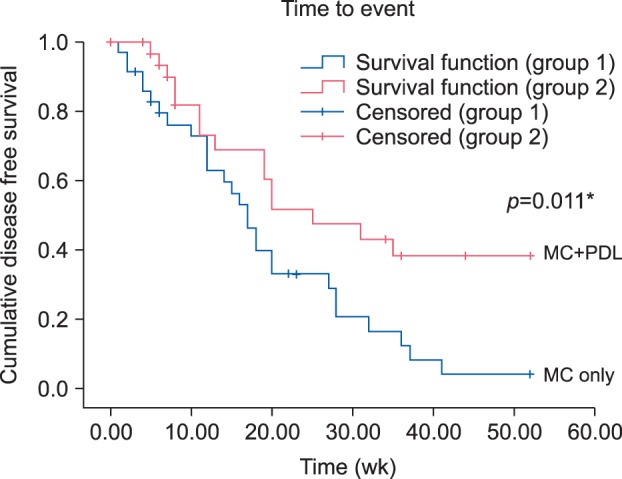Ann Dermatol.
2017 Oct;29(5):543-547. 10.5021/ad.2017.29.5.543.
Pulsed Dye Laser Treatment Combined with Oral Minocycline Reduces Recurrence Rate of Rosacea
- Affiliations
-
- 1Department of Dermatology, Inha University School of Medicine, Incheon, Korea. mikie2001@hanmail.net
- 2Department of Biomedical Sciences, Inha University School of Medicine, Incheon, Korea.
- KMID: 2388904
- DOI: http://doi.org/10.5021/ad.2017.29.5.543
Abstract
- BACKGROUND
The recurrence rate of rosacea was not known very well, but has been reported as 60% in 6 months after withdrawal of the drug. It is not known which treatment can reduce relapses of rosacea effectively.
OBJECTIVE
The objective was to identify whether 595 nm-pulsed dye laser (PDL) treatment reduced recurrence rate among rosacea patients who were treated with oral minocycline.
METHODS
One hundred and seven Korean patients with rosacea who started treatment with oral minocycline (100 mg/d) with or without PDL (2∼4 sessions) were evaluated retrospectively. The recurrence rate was estimated using the Kaplan-Meier method, and difference was evaluated using the log-rank test. Cox proportional hazards model was used to estimate hazard ratios and 95% confidence intervals (CIs) of risk factors for the recurrence of rosacea.
RESULTS
The recurrence-free survival analysis revealed that the group with oral minocycline plus PDL was significantly different compared with the group with oral minocycline alone (p=0.011). Cox proportional hazards model showed that the combined use of PDL with oral minocycline appeared to be a significant protective factor for the hazard of recurrence of rosacea (hazard ratio, 0.492; 95% CI, 0.257∼0.941; p=0.032).
CONCLUSION
PDL can be used added to oral minocycline to reduce relapses among rosacea patients who are undergoing oral minocycline treatment.
Keyword
MeSH Terms
Figure
Reference
-
1. Two AM, Wu W, Gallo RL, Hata TR. Rosacea: part I. Introduction, categorization, histology, pathogenesis, and risk factors. J Am Acad Dermatol. 2015; 72:749–758. PMID: 25890455.2. Korting HC, Schöllmann C. Current topical and systemic approaches to treatment of rosacea. J Eur Acad Dermatol Venereol. 2009; 23:876–882. PMID: 19508315.
Article3. Jackson JM, Kircik LH, Lorenz DJ. Efficacy of extended-release 45 mg oral minocycline and extended-release 45 mg oral minocycline plus 15% azelaic acid in the treatment of acne rosacea. J Drugs Dermatol. 2013; 12:292–298. PMID: 23545911.4. Del Rosso JQ, Webster GF, Jackson M, Rendon M, Rich P, Torok H, et al. Two randomized phase III clinical trials evaluating anti-inflammatory dose doxycycline (40-mg doxycycline, USP capsules) administered once daily for treatment of rosacea. J Am Acad Dermatol. 2007; 56:791–802. PMID: 17367893.
Article5. Two AM, Wu W, Gallo RL, Hata TR. Rosacea: part II. Topical and systemic therapies in the treatment of rosacea. J Am Acad Dermatol. 2015; 72:761–770. PMID: 25890456.6. Pelle MT. Rosacea. In : Goldsmith L, Katz S, Gilchrest B, Paller A, Leffell D, Wolff K, editors. Fitzpatrick's dermatology in general medicine. 8th ed. New York: McGraw-Hill;2012. p. 918–924.7. Kim TG, Roh HJ, Cho SB, Lee JH, Lee SJ, Oh SH. Enhancing effect of pretreatment with topical niacin in the treatment of rosacea-associated erythema by 585-nm pulsed dye laser in Koreans: a randomized, prospective, split-face trial. Br J Dermatol. 2011; 164:573–579. PMID: 21143465.
Article8. Erceg A, de Jong EM, van de Kerkhof PC, Seyger MM. The efficacy of pulsed dye laser treatment for inflammatory skin diseases: a systematic review. J Am Acad Dermatol. 2013; 69:609–615.e8. PMID: 23711766.
Article9. Lonne-Rahm S, Nordlind K, Edström DW, Ros AM, Berg M. Laser treatment of rosacea: a pathoetiological study. Arch Dermatol. 2004; 140:1345–1349. PMID: 15545543.10. Salem SA, Abdel Fattah NS, Tantawy SM, El-Badawy NM, Abd El-Aziz YA. Neodymium-yttrium aluminum garnet laser versus pulsed dye laser in erythemato-telangiectatic rosacea: comparison of clinical efficacy and effect on cutaneous substance (P) expression. J Cosmet Dermatol. 2013; 12:187–194. PMID: 23992160.
Article11. Aksoy B, Altaykan-Hapa A, Egemen D, Karagöz F, Atakan N. The impact of rosacea on quality of life: effects of demographic and clinical characteristics and various treatment modalities. Br J Dermatol. 2010; 163:719–725. PMID: 20545683.
Article12. Knight AG, Vickers CF. A follow-up of tetracycline-treated rosacea. With special reference to rosacea keratitis. Br J Dermatol. 1975; 93:577–580. PMID: 128376.13. Mikkelsen PR, Dufour DN, Zarchi K, Jemec GB. Recurrence rate and patient satisfaction of CO2 laser evaporation of lesions in patients with hidradenitis suppurativa: a retrospective study. Dermatol Surg. 2015; 41:255–260. PMID: 25654196.14. Roland CL, Boland GM, Demicco EG, Lusby K, Ingram D, May CD, et al. Clinical observations and molecular variables of primary vascular leiomyosarcoma. JAMA Surg. 2016; 151:347–354. PMID: 26629783.
Article15. Tan ST, Bialostocki A, Armstrong JR. Pulsed dye laser therapy for rosacea. Br J Plast Surg. 2004; 57:303–310. PMID: 15145732.
Article16. Bernstein EF, Kligman A. Rosacea treatment using the new-generation, high-energy, 595 nm, long pulse-duration pulsed-dye laser. Lasers Surg Med. 2008; 40:233–239. PMID: 18412227.
Article17. Togsverd-Bo K, Wiegell SR, Wulf HC, Haedersdal M. Short and limited effect of long-pulsed dye laser alone and in combination with photodynamic therapy for inflammatory rosacea. J Eur Acad Dermatol Venereol. 2009; 23:200–201. PMID: 18452529.
Article18. Wereide K. Long-term treatment of rosacea with oral tetracycline. Acta Derm Venereol. 1969; 49:176–179. PMID: 4184565.
- Full Text Links
- Actions
-
Cited
- CITED
-
- Close
- Share
- Similar articles
-
- A Study of the Therapeutic Effect of Rosacea by the Flashlamp - Pumped Pulsed Dye Laser ( SPTL - 1 )
- The Use of Pulsed Dye Laser for the Treatment of Xanthelasma Palpebrum
- Maintenance of Remission after Oral Metronidazole Add-on Therapy in Rosacea Treatment: A Retrospective, Comparative Study
- Prospective Comparison of Dual Wavelength Long-Pulsed 755-nm Alexandrite/1,064-nm Neodymium:Yttrium-Aluminum-Garnet Laser versus 585-nm Pulsed Dye Laser Treatment for Rosacea
- Intense pulsed light as an alternative treatment for erythematotelangiectatic rosacea: a case report


